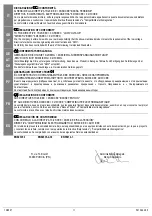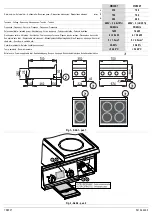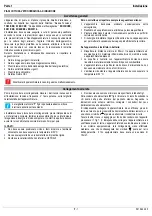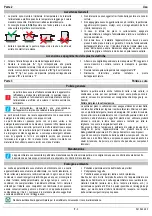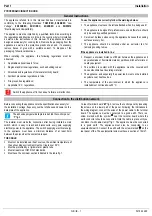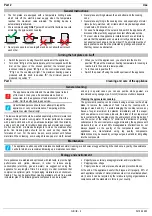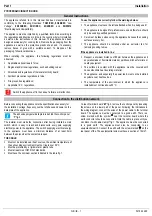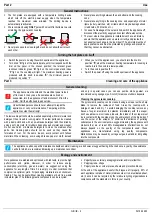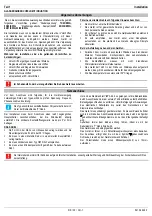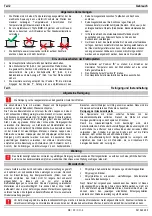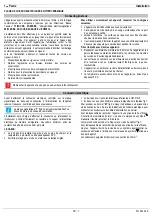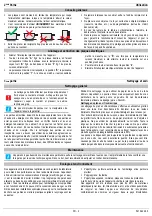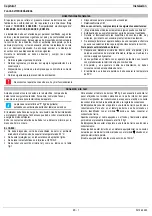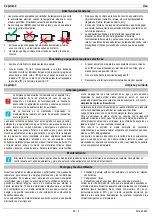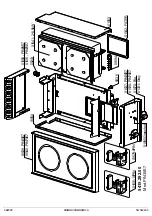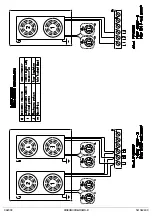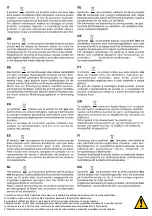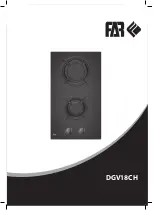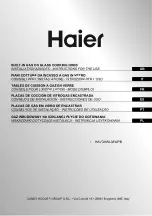
GB / IE - 2
5410.424.00
Part 2
Use
General Instructions
The hot plates are equipped with a temperature limiting device
which cuts off the electric power supply when the temperature
reaches the maximum value allowed. The limiting device is
automatically reactivated.
We recommend using ONLY pots with smooth flat bottoms to avoid
scratching the pyroceramic cook top.
Never place pans too close together and do not allow them to touch
each other.
Never place anything between the pan bottom and the cooking
zone.
Never place anything in the cooking zone, and especially not metal
items (cutlery, watches, etc) or items which may be demagnetized
(credit cards, ATM cards, etc.).
In case of a breakage of the ceramic hob, switch the appliance off,
disconnect the electricity supply and contact after-sales service.
The room where the appliance is installed must have air inlets to
ensure that the appliance can operate correctly and provide the
necessary air exchange in the room itself. The air inlets must be of
appropriate size and must be protected by gratings and placed so
that they cannot be obstructed.
Turning the hot plates on & off
Switch the power on using the switch upstream of the appliance.
Turn knob “A” fig.2 of the desired plate, until it corresponds with the
dial on the panel in the chosen position; the relevant green
luminous indicator green “B” fig.2 on the control panel and index
“F” fig.1 on the cooktop will light. The maximum heating power is
produced with the knob in position “
6
”, the minimum power is
produced in position “1”.
When you turn the appliance on, you should turn the knob to
position “
6
”; when the maximum heating temperature for cooking is
reached, turn the knob to a lower position.
Turn the knob to position “0”.
Switch the power off using the switch upstream of the appliance.
Part 3
Cleaning and care of the appliance
General cleaning
The appliance must be cold and the electrical power turned
off to clean it. In any case, if anomalies are noticed or
suspected, turn the appliance off and disconnect it from the
mains. Call the authorised repair service.
Unauthorised persons should never attempt to repair the
appliance, or carry out maintenance. Tampering with the
appliance voids the warranty!
The removable parts should be washed separately with warm water and
detergent, then rinsed in running water. The steel parts can be cleaned
with a damp cloth and with a non-abrasive detergent and then dried by
using a soft, dry cloth; for stubborn deposits use hot water and vinegar.
Do not use harsh or abrasive detergents to clean the stainless steel
parts. Iron cleaning pads should not be used as they cause the
formation of rust. For the same reason, avoid contact with ferrous
materials. When cleaning, avoid using abrasive paper or cloth; instead
and only in special cases you can use pumice stone powder; we
recommend using sponges (ex. Scotch) to remove stubborn deposits.
Cleaning the pyroceramic cooktop
The pyroceramic cooktop can be cleaned using a scraper with a sharp
blade to remove the residues of food. Clean the cooktop with a
detergent, wash and dry. To avoid damaging the cooktop remove any
traces of sugar, aluminium foil plastics immediately with the scaper;
don't use abrasive or corrosive products, the blade of the scraper must
be in contact with the cooktop along the entire length of the blade; don't
use the corner of the scraper. To minimise the emission of polluting
substances in the environment we suggest cleaning the appliance with
products that are at least 90% biodegradable. Malfunctions do not
always depend on the quality of the components used. These
appliances are manufactured using top quality components.
Malfunctions may be caused by voltage surges, dust and/or dirt getting
into the components.
Maintenance
The appliance needs no specific maintenance besides normal cleaning; we do however suggest having it checked once a year by the assistance
centre for which, we recommend drawing up a maintenance contract.
Ecology and environment
Our appliances are studied and optimised, with lab tests, to provide high
performance and yields. However, in order to reduce energy
consumption (electricity, gas and water), we suggest not using the
appliance for any length of time if it is empty or under conditions that
compromise optimum yield. All packaging materials are environment-
friendly. They can be kept without creating problems or burnt in a waste
incinerator plant. The following plastic components can be recycled:
Polyethylene: external packaging material and/or pluribol film
Polypropylene: straps
Polystyrene foam: corner pieces, sheets and protection blocks
At the end of the appliance’s useful life, dispose of it properly. 90% of
each appliance is made of metal (stainless steel, iron, aluminated sheet,
etc.) hence it can be recycled by the relative recycling organisations in
compliance with the standards in force in your country.


